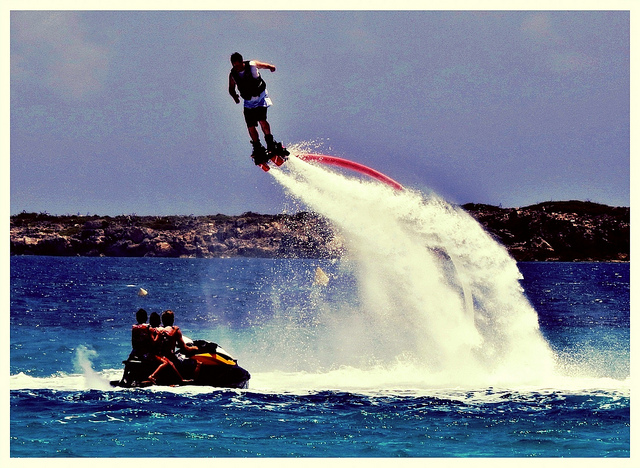Archive for the ‘How To’ Category
People Are The Best Investment
 Anything that happens happens because of people, and anything that doesn’t happen doesn’t happen because of people. Technology doesn’t create itself, products don’t launch themselves, companies don’t build themselves and trust doesn’t grow on its own. Any kind of work, any kind of service, any kind of organizing – it’s all done by people.
Anything that happens happens because of people, and anything that doesn’t happen doesn’t happen because of people. Technology doesn’t create itself, products don’t launch themselves, companies don’t build themselves and trust doesn’t grow on its own. Any kind of work, any kind of service, any kind of organizing – it’s all done by people.
The productivity/quality movement has been good for factories – parts move in a repeatable flow and they’re processed in repeatable ways by machines that chunk out repeatable output. Design the process, control the inputs and turn the crank. Invest in the best machines and to do the preventative maintenance to keep them in tip-top shape. Just follow the preventive maintenance (PM) schedule and you’ll be fine. But when the productivity/quality movement over-extended into the people domain, things don’t go as well.
People aren’t machines, and their work product is not cookie-cutter parts. And, there’s no standard PM schedule for people. We all know this, but we behave like people are machines – we design their work process, train them on it and measure their output. But machines are iron-based entities that don’t have consciousness and people are carbon-based beings with full consciousness. The best machines do what their told, but the best people tell you what to do. Machines and people are fundamentally different, but how we run them is markedly similar.
Where machines need oil, people need empathy. And for empathy you need vulnerability and for that you need trust. But there’s no standard PM schedule for trust. There’s no flowchart or troubleshooting protocol for helping people. What work do you give them? It depends. When do you touch base and when do you leave them alone? It depends. How much responsibility do you give them? It depends. With machines it’s follow the PM schedule and with people – it depends.
Where machines wear out, people develop and grow. And to grow people you need to see them as they are and meet them where they are. And to do that you’ve got to see yourself as you are. You can’t give people what they need if you add to the drama with your reactivity and you can’t discern their suffering from your projections if you’re not grounded. How much time do you spend each day to learn to dampen your reactivity? How much time do you spend to slow your monkey mind so you can see your projections?
With machines it’s control the inputs and get what you got last time. With people it’s maybe; it depends; don’t worry about how it will go; and why don’t you try? Growing people is much more difficult than keeping machines running smoothly. But, there is nothing more fulfilling than helping people grow into something they couldn’t imagine.
Image credit – Benjamin Balazs
Hep
When doing new work, you’ll be wrong.
 When doing something from the first time you’re going to get it wrong. There’s no shame in that because that’s how it goes with new work. But more strongly, if you don’t get it wrong you’re not trying hard enough. And more strongly, embrace the inherent wrongness as a guiding principle.
When doing something from the first time you’re going to get it wrong. There’s no shame in that because that’s how it goes with new work. But more strongly, if you don’t get it wrong you’re not trying hard enough. And more strongly, embrace the inherent wrongness as a guiding principle.
Take Small Bites. With new work, a small scope is better than a large one. But it’s exciting to do new work and there’s a desire to deliver as much novel usefulness as possible. And, without realizing it, the excitement can lead to a project bloated with novelty. With the best intentions, the project team is underwater with too much work and too little time. With new work, it’s better to take one bite and swallow than three and choke.
Ratchet Thinking. With new work comes passion and energy. And though the twins can be helpful and fun to have around, they’re not always well-behaved. Passion can push a project forward but can also push it off a cliff. Energy creates pace and can quickly accelerate a project though the milestones, but energy can be careless and can just as easily accelerate a project in the wrong direction. And that’s where ratchet thinking can help.
As an approach, the objective of ratchet thinking is to create small movements in the right direction without the possibility of back-sliding. Solve a problem and click forward one notch; solve a second problem and click forward another notch. But, with ratchet thinking, if the third problem isn’t solved, the project holds its ground at the second notch. It takes a bit more time to choose the right problem and to solve it in a way that cannot unwind progress, but ultimately it’s faster. Ratchet thinking takes the right small bite, chews, swallows.
Zero Cost of Change. New work is all about adding new functions, enhancing features and fixing what’s broken. In other words, new work is all about change. And the faster change can happen, the faster the product/service/business model is ready for sale. But as the cost of change increases the rate of changes slows. So why not design the project to eliminate the cost of change?
To do that, design the hardware with a bit more capability and headroom so there’s some wiggle room to handle the changes that will come. Use a modular approach for the software to minimize the interactions of software changes and make sure the software can be updated remotely without customer involvement. And put in place a good revision control (and tracking) mechanism.
Doing new work is full of contradictions: move quickly, but take the time to think things through; take on as much as you can, but no more; be wrong, but in the right way; and sometimes slower is faster.
But doing new work you must.
image credit – leasqueaky
Why not do new work?
 Doing new work isn’t difficult, thinking about is difficult. Stop thinking and start starting; there’s no other way.
Doing new work isn’t difficult, thinking about is difficult. Stop thinking and start starting; there’s no other way.
If you’re a scientist, everything has a half-life. If you’re Buddhist, everything is impermanent. If you’re a CEO, your business model is out of gas. It’s scary to admit everything goes away, but it’s far scarier to deny it.
Just because an idea is threatening doesn’t mean it’s threatening. It probably means it’s one hell of a good idea.
If it’s not different, it can’t be innovation.
Projects take too long because they’re poorly defined. On a single page, define the novel usefulness the project will deliver, make a crude prototype and show it to potential customers. Refine, learn and repeat. Then launch it. (This is the essence of Lean Startup without all the waste.)
If I could choose my competition, I’d choose to compete with no one.
Failure is never the right word. Don’t use it. Ever. (Even failing forward or forward failing should not be used.) No one wants to fail. No one will ever want to fail. Replace of the word “failure” with “learning” and learn quickly.
If you’re not scared, you’re not doing innovation.
Companies offer more-with-less for as long as they can; and when there’s nothing left they offer more-with-more. It would be better to offer less-with-far-less.
For Franklin D. Roosevelt, the only thing to fear was fear itself. For business, the only thing to fear is the cow path of success.
Image credit – JasonParis
How To Learn Quickly
 When the work is new, it all comes down to learning. And with learning it all comes down to three questions:
When the work is new, it all comes down to learning. And with learning it all comes down to three questions:
- What do you want to learn?
- What actions will take to learn what you want to learn?
- How will you decide if you learned what you wanted to learn?
There are many definitions of learning. To me, when your beliefs change, that’s learning. If your hunch moves to a validated idea, that’s learning. If your understanding of a system moves from “I don’t know” to “I know a little bit.”, that’s learning. If you believed your customers buy your product for Feature A and now you know they really buy it because of Feature B, that’s learning.
What do you want to learn? The best place to start is to clearly define what you want to learn. Sounds easy, but it’s not. Some of the leading thinking recommends you define a formal hypothesis. I don’t like that word. It’s scary, intimidating and distracting. It’s just not helpful. Instead, I suggest you define a Learning Objective. To do that, complete this sentence:
I want to learn if the customer ____________________.
It may take several iterations/meetings to agree on a Learning Objective, but that’s time well spent. It’s faster to take the time to define what you want to learn than to quickly learn something that doesn’t matter. And define the Learning Objective as narrowly as possible. The tighter the Learning Objective, the faster you can learn it.
What actions will you take to learn what you want to learn? In other words, for every Learning Objective create a Learning Plan. Use the Who, What, When format. Define Who will do What and When they’ll be done. To increase the learning rate, define the minimum work to fulfill the narrowly-defined Learning Objective. Just as you defined the Learning Objective narrowly, define the Learning Plan narrowly. And to further speed the learning, set constraints like – no one can travel to see customers; no more than five customers can be contacted; and the Learning Plan must be completed in two days. You’re not looking for large sample sizes and statistical significance; you’re looking to use your best judgement supported by the minimum learning to create reasonable certainty.
How will you decide if you learned what you wanted to learn? Learning requires decisions, decisions require judgement and judgement requires supporting information. As part of the Learning Plan, define the Learning Information you’ll collect/capture/record to support your decisions. Audio recordings are good and video is better. For fast learning, you can record a phone call with a customer or ask them to share their webcam (and record the feed) as you talk with them. Or you can ask them to shoot some video with their smart phone to provide the information needed to achieve you Learning Objective.
To analyze the data, it’s best to review the audio/video as a group and talk about what you see. You should watch for body language as well as listen to the words. Don’t expect complete agreement among your team and expect to create follow-on Learning Objectives and Learning Plans to answer the open questions. Repeat the process until there’s enough agreement to move forward, but don’t wait for 100% consensus.
When you present your learning to company leadership, show the raw video data that supports your learning. Practically, you’ll connect company leaders to customers and let the customers dispel long-held biases and challenge old thinking.
There’s nothing more powerful than a customer telling your company leaders how things really are.
Image credit – Thomas Hawk
How To Create Eye-Watering Ideas
 With creativity, the leading thinking says the most important thing is to create many of ideas. When asked to generate many of ideas, the thinking goes, the team lets go of their inhibitions and good ideas slip through their mental filters. I’ve found that thinking misleading. I’ve found that creating many ideas results in many ideas, but that’s it. Before the session to create new ideas, you already had a pile of ideas you weren’t working on, and after the session is bigger, but not better.
With creativity, the leading thinking says the most important thing is to create many of ideas. When asked to generate many of ideas, the thinking goes, the team lets go of their inhibitions and good ideas slip through their mental filters. I’ve found that thinking misleading. I’ve found that creating many ideas results in many ideas, but that’s it. Before the session to create new ideas, you already had a pile of ideas you weren’t working on, and after the session is bigger, but not better.
What’s needed is several outlandish ideas that make your hair stand on end. The ideas should be so different that they cause you to chuckle to mask your discomfort. These ideas should be borderline unbelievable and just south of impossible. The ideas should have the possibility to change the game and tip your industry on its head.
The “many ideas” thinking has the right intent – to loosen the team’s thinking so they generate good ideas, but the approach is insufficient. To force the team to generated outlandish ideas they must be turned inside-out and put on the rack. Heretical ideas don’t come easily and drastic measures are needed. The team must be systematically stripped of the emotional constraints of their success using the Innovation Burst Event (IBE) method.
To prepare for the IBE, a reward-looking analysis is done to identify traditional lines of customer goodness (for example, miles per gallon for automobiles) and define how that goodness has changed over time (position it on the S-curve.) If the improvement has been flat, it’s time for a new line of customer goodness, and if the goodness is still steadily increasing, it’s time to create a new technology that will provide the next level of improvement. With this analysis the disposition of the system is defined and potentially fertile design space is identified. And within this design space, design challenges are created that force the team to exercise the highly fertile design space during the IBE.
Everything about the IBE is designed to strip the team of its old thinking. The IBE is held at an offsite location to change the scenery and eliminate reminders of traditional thinking and good food is served to help the team feel the day is special. But the big medicine is the design challenges. They are crafted to outlaw traditional thinking and push the team toward new thinking. The context is personal (not corporate) and the scale of the challenge is purposefully small to help the team let go of adjacent concerns. And, lastly, the team is given an unreasonably short time (five to ten minutes) to solve the problem and build a thinking prototype (a prototype that stands for an idea, not at functional prototype.)
Everything about the IBE helps the team let go of their emotional constraints and emit eye-watering solutions. The design challenges force them to solve problems in a new design space in a way and does not give them a chance to limit their thinking in any way. The unrealistic time limit is all-powerful.
Four design challenges is about all team can handle in the one-day IBE. With the IBE they come up with magical ideas clustered around four new areas, new areas that have the potential to flip your industry on its head. In one day, a team can define market-changing ideas that obsolete your best products and even your business model. Not bad for one day.
It may be popular wisdom that it’s best to create many new ideas, but it’s not the best way. And it contradicts popular belief that a team can create three or four game-changing ideas in a single day. But the IBEs work as advertised.
Don’t waste time creating a pile of ideas. Spend the time to identify fertile design space and hold a one-day IBE to come up with ideas that will create your future.
Image credit – moonjazz
Diabolically Simple Questions
 Today’s work is complicated with electronic and mechanical subsystems wrapped in cocoons of software; coordination of matrixed teams; shared resources serving multiple projects; providing world class services in seventeen languages on four continents. And the complexity isn’t limited to high level elements. There is a living layer of complexity growing on all branches of the organization right down to the leaf level.
Today’s work is complicated with electronic and mechanical subsystems wrapped in cocoons of software; coordination of matrixed teams; shared resources serving multiple projects; providing world class services in seventeen languages on four continents. And the complexity isn’t limited to high level elements. There is a living layer of complexity growing on all branches of the organization right down to the leaf level.
Complexity is real, and it complicates things. To run projects and survive in the jungle of complexity it’s important to know how to put the right pieces together and provide the right answers. But as a leader it’s more important to slash through the complexity and see things as they are. And for that, it’s more important to know how ask diabolically simple questions (DSQ).
Project timelines are tight and project teams like to start as soon as they can. Too often teams start without clarity on what they’re trying to achieve. At these early stages the teams make record progress in the wrong direction. The leader’s job is to point them in the right direction, and here’s the DSQ to set them on their way: What are you trying to achieve?
There will likely be some consternation, arm waiving and hand wringing. After the dust settles, help the team further tighten down the project with this follow-on DSQ: How will you know you achieved it?
For previous two questions there are variants that works equally well for work that closer to the fuzzy front end: What are you trying to learn? and How will you know you learned it?
There is no such thing as a clean-sheet project and even the most revolutionary work builds on the existing system. Though the existing business model, service or product has been around for a long time, the project team doesn’t really know how it works. They know they should know but they’re afraid to admit it. Let them off the hook with this beauty: How does it work today?
After the existing system is defined with a simple block diagram (which could take a couple weeks) it’s time to help the project team focus their work. The best DSQ for the job: How is it different from the existing system? If the list is too long there’s too much newness and if it’s too short there’s not enough novelty. If they don’t know what’s different, ask them to come back when they know.
After the “what’s different” line of questioning, the team must be able to dive deeper. For that it’s time one of the most powerful DSQs in the known universe: What problem are you trying to solve? Expect frustration and complicated answers. Ask them to take some time and for each problem describe it on a single page using less than ten words. Suggest a block diagram format and ask them to define where and when the problem occurs. (Hint: a problem is always between two components/elements of the system.) And the tricky follow-on DSQ: How will you know you solved it? No need to describe the reaction to that one.
Though not an exhaustive list, here are some of my other favorite DSQs:
Who will buy it, how much will they pay, and how do you know?
Have we done this before?
Have you shown it to a real customer?
How much will it cost and how do you know?
Whose help do we need?
If the prototype works, will we actually do anything with it?
Diabolically simple questions have the power to heal the project teams and get them back on track. And over time, DSQs help the project teams adopt a healthy lifestyle. In that way, DSQs are like medicine – they taste bad but soon enough you feel better.
Image credit – Daniela Hartmann
How To Allocate Resources
 How a company allocates its resources defines its strategy. But it’s tricky business to allocate resources in a way that makes the most of the existing products, services and business models yet accomplishes what’s needed to create the future.
How a company allocates its resources defines its strategy. But it’s tricky business to allocate resources in a way that makes the most of the existing products, services and business models yet accomplishes what’s needed to create the future.
To strike the right balance, and before any decisions on specific projects, allocate the desired spending into three buckets – short, medium and long. Or, if you prefer, Horizon 1, 2 and 3. Use the business objectives to set the weighting. Then, sit next to the CFO for a couple days and allocate last year’s actual spending to the three buckets and compare the actuals with how resources will be allocated going forward. Define the number of people who will work on short, medium and long and how many will move from one bucket to another.
To get the balance right, short term projects are judged relative to short term projects, medium term projects are judged relative to medium term projects and the long term ones are judged against their long term peers. Long term projects cannot be staffed at the expense of short term projects and medium term projects cannot take resources from long term projects. To get the balance right, those are the rules.
To choose the best projects within each bucket, clarity and constraints are more important than ROI. Here are some questions to improve clarity and define the constraints.
How will the customer benefit? It’s best to show the customer using the product or service or experiencing the new business model. Use a hand sketch and few, if any, words. Use one page.
How is it different? In the hand sketch above, draw the novel (different) elements in red.
Who is the new customer? Define where they live, the language they speak and how they get the job done today.
Are there regional constraints? Infrastructure gaps, such as electricity, water, transportation are deal breakers. Language gaps can be big problems, so can regulatory, legal and cultural constraints. If a regional constraint cannot be overcome, do something else.
How will your company make money? Use this formula: (price – cost) x volume. But, be clear about the size of the market today and the size it could be in five years.
How will you make, sell and service it? Include in the cost of the project the cost to overcome organizational capacity/capability constraints. If cost (or time) to close the gaps is prohibitive, do something else.
How will the business model change? If it won’t, strongly consider a different project.
If the investigations show the project is worthwhile, how would you staff the project and when? This is an important one. If the project would be a winner, but there is no one to work on it, do something else. Or, consider stopping a bad project to start the good one.
There’s usually a general tendency to move medium term resources to short term projects and skimp on long term projects. Be respectful of the newly-minted resource balance defined at the start and don’t choose a project from one bucket over a project from another. And don’t get carried away with ROI measured to three significant figures, rather, hold onto the fact that an insurmountable constraint reduces ROI to zero.
And staff projects fully. Partially-staffed projects set expectations that good things are happening, but they never come to be.
Image credit – john curley
Channel your inner sea captain.
 When it’s time for new work, the best and smartest get in a small room to figure out what to do. The process is pretty simple: define a new destination, and, to know when they journey is over, define what it looks like to live there. Define the idealized future state and define the work to get there. Turn on the GPS, enter the destination and follow the instructions of the computerized voice.
When it’s time for new work, the best and smartest get in a small room to figure out what to do. The process is pretty simple: define a new destination, and, to know when they journey is over, define what it looks like to live there. Define the idealized future state and define the work to get there. Turn on the GPS, enter the destination and follow the instructions of the computerized voice.
But with new work, the GPS analogy is less than helpful. Because the work is new, there’s no telling exactly where the destination is, or whether it exists at all. No one has sold a product like the one described in the idealized future state. At this stage, the product definition is wrong. So, set your course heading for South America though the destination may turn out to be Europe. No matter, it’s time to make progress, so get in the car and stomp the accelerator.
But with new work there is no map. It’s never been done before. Though unskillful, the first approach is to use the old map for the new territory. That’s like using map data from 1928 in your GPS. The computer voice will tell you to take a right, but that cart path no longer exists. The GPS calls out instructions that don’t match the street signs and highway numbers you see through the windshield. When the GPS disagrees with what you see with your eyeballs, the map is wrong. It’s time to toss the GPS and believe the territory.
With new work, it’s not the destination that’s important, the current location is most important. The old sea captains knew this. Site the stars, mark the time, and set a course heading. Sail for all your worth until the starts return and as soon as possible re-locate the ship, set a new heading and repeat. The course heading depends more on location than destination. If the ship is east of the West Indies, it’s best to sail west, and if the ship is to the north, it’s best to sail south. Same destination, different course heading.
When the work is new, through away the old maps and the GPS and channel your inner sea caption. Position yourself with the stars, site the landmarks with your telescope, feel the wind in your face and use your best judgement to set the course heading. And as soon as you can, repeat.
Image credit – Timo Gufler.
Stop bad project and start good ones.
 At the most basic level, business is about allocating resources to the best projects and executing those projects well. Said another way, business is about deciding what to work on and then working effectively. But how to go about deciding what to work on? Here is a cascade of questions to start you on your journey.
At the most basic level, business is about allocating resources to the best projects and executing those projects well. Said another way, business is about deciding what to work on and then working effectively. But how to go about deciding what to work on? Here is a cascade of questions to start you on your journey.
What are your company’s guiding principles? Why does it exist? How does it want to go about its life? These questions create context from which to answer the questions that follow. Once defined, all your actions should align with your context.
How has the business environment changed? This is a big one. Everything is impermanent. Change is the status quo. What worked last time won’t work this time. Your success is your enemy because it stunts intentions to work on new things. Define new lines of customer goodness your competitors have developed; define how their technologies have increased performance; search YouTube to see the nascent technologies that will displace you; put yourself two years in the future where your customers will pay half what they pay today. These answers, too, define the context for the questions that follow.
What are you working on? Define your fully-staffed projects. Distill each to a single page. Do they provide new customer value? Are the projects aligned with your company’s guiding principles? For those that don’t, stop them. How do your fully-staffed projects compare to the trajectory of your competitors’ offerings? For those that compare poorly, stop them.
For projects that remain, do they meet your business objectives? If yes, put your head down and execute. If no, do you have better projects? If yes, move the freed up resources (from the stopped projects) onto the new projects. Do it now. If you don’t have better projects, find some. Use lines of evolution for technological systems to figure out what’s next, define new projects and move the resources. Do it now.
The best leading indicator of innovation is your portfolio of fully-staffed projects. Where other companies argue and complain about organizational structure, move your best resources to your best projects and execute. Where other companies use politics to trump logic, move your best resources to your best projects and execute. Where other successful companies hold on to tired business models and do-what-we-did-last-time projects, move your best resources to your best projects and execute.
Be ruthless with your projects. Stop the bad ones and start some good ones. Be clear about what your projects will deliver – define the novel customer value and the technical work to get there. Use one page for each. If you can’t define the novel customer value with a simple cartoon, it’s because there is none. And if you can’t define how you’ll get there with a hand sketch, it’s because you don’t know how.
Define your company’s purpose and use that to decide what to work on. If a project is misaligned, kill it. If a project is boring, don’t bother. If it’s been done before, don’t do it. And if you know how it will go, do something else.
If you’re not changing, you’re dying.
Image credit – David Flam
The Chief Innovation Mascot
 I don’t believe the role of Chief Innovation Officer has a place in today’s organizations. Today, it should be about doing the right new work to create value. That work, I believe, should be done within the organization as a whole or within dedicated teams within the organization. That work, I believe, cannot be done by the Chief Innovation Officer because the organizational capability and capacity under their direct control is hollow.
I don’t believe the role of Chief Innovation Officer has a place in today’s organizations. Today, it should be about doing the right new work to create value. That work, I believe, should be done within the organization as a whole or within dedicated teams within the organization. That work, I believe, cannot be done by the Chief Innovation Officer because the organizational capability and capacity under their direct control is hollow.
Chief Innovation Officers don’t have the resources under their control to do innovation work. That’s the fundamental problem. Without the resources to invent, validate and commercialize, the Chief Innovation Officer is really the Chief Innovation Mascot- an advocate for the cause who wears the costume but doesn’t have direct control over the work.
Companies need to stop talking about innovation as a word and start doing the work that creates new products and services for new customers in markets. It all starts with the company’s business objectives (profitability goals) and an evaluation of existing projects to see if they’ll meet those objectives. If they will, then it’s about executing those projects. (The Chief Innovation Officer can’t help here because that requires operational resources.) If they won’t, it’s about defining and executing new projects that deliver new value to new customers. (Again, this is work for deep subject matter experts across multiple organizations, none of which work for the Chief Innovation Officer.)
To create a non-biased view of the projects, identify lines of customer goodness, measure the rate of change of that goodness, assess the underpinning technologies (momentum, trajectory, maturity and completeness) and define the trajectory of the commercial space. This requires significant resource commitments from marketing, engineering and sales, resource commitments The Chief Innovation Officer can’t commit. Cajole and prod for resources, yes. Allocate them, no.
With a clear-eyed view of their projects and the new-found realization that their projects won’t cut it, companies can strengthen their resolve to do new work in new ways. The realization of an immanent shortfall in profits is the only think powerful enough to cause the company to change course. The company then spends the time to create new projects and (here’s the kicker) moves resources to the new projects. The most articulate and persuasive Chief Innovation Officer can’t change an organization’s direction like that, nor can they move the resources.
To me it’s not about the Chief Innovation Officer. To me it’s about creating the causes and conditions for novel work; creating organizational capability and capacity to do the novel work; and applying resources to the novel work so it’s done effectively. And, yes, there are tools and methods to do that work well, but all that is secondary to allocating organizational capacity to do new work in new ways.
When Chief Innovation Officer are held accountable for “innovation objectives,” they fail because they’re beholden to the leaders who control the resources. (That’s why their tenures are short.) And even if they did meet the innovation objectives, the company would not increase it’s profits because innovation objectives don’t pay the bills. The leaders that control the resources must be held accountable for profitability objectives and they must be supported along the way by people that know how to do new work in new ways.
Let’s stop talking about innovation and the officers that are supposed to do it, and let’s start talking about new products and new services that deliver new value to new customers in new markets.
Image credit – Neon Tommy
Dissent Without Reprisal – a key to company longevity
 In strategic planning there’s a strong forcing function that causes the organization to converge on a singular, company-wide approach. While this convergence can be helpful, when it’s force is absolute it stifles new ideas. The result is an operating plan that incrementally improves on last year’s work at the expense of work that creates new businesses, sells to new customers and guards against the dark forces of disruptive competition. In times of change convergence must be tempered to yield a bit of diversity in the approach. But for diversity to make it into the strategic plan, dissent must be an integral (and accepted) part of the planning process. And to inject meaningful diversity the dissenting voice must be as load as the voice of convergence.
In strategic planning there’s a strong forcing function that causes the organization to converge on a singular, company-wide approach. While this convergence can be helpful, when it’s force is absolute it stifles new ideas. The result is an operating plan that incrementally improves on last year’s work at the expense of work that creates new businesses, sells to new customers and guards against the dark forces of disruptive competition. In times of change convergence must be tempered to yield a bit of diversity in the approach. But for diversity to make it into the strategic plan, dissent must be an integral (and accepted) part of the planning process. And to inject meaningful diversity the dissenting voice must be as load as the voice of convergence.
It’s relatively easy for an organization to come to consensus on an idea that has little uncertainty and marginal upside. But there can be no consensus, but on an idea with a high degree of uncertainty even if the upside is monumental. If there’s a choice between minimizing uncertainty and creating something altogether new, the strategic process is fundamentally flawed because the planning group will always minimize uncertainty. Organizationally we are set up to deliver certainty, to make our metrics and meet our timelines. We have an organizational aversion to uncertainty, and, therefore, our organizational genetics demand we say no to ideas that create new business models, new markets and new customers. What’s missing is the organizational forcing function to counterbalance our aversion to uncertainty with a healthy grasping of it. If the company is to survive over the next 20 years, uncertainty must be injected into our organizational DNA. Organizationally, companies must be restructured to eliminate the choice between work that improves existing products/services and work that creates altogether new markets, customers, products and services.
When Congress or the President wants to push their agenda in a way that is not in the best long term interest of the country, no one within the party wants to be the dissenting voice. Even if the dissenting voice is right and Congress and the President are wrong, the political (career) implications of dissent within the party are too severe. And, organizationally, that’s why there’s a third branch of government that’s separate from the other two. More specifically, that’s why Justices of the Supreme Court are appointed for life. With lifetime appointments their dissenting voice can stand toe-to-toe with the voice of presidential and congressional convergence. Somehow, for long-term survival, companies must find a way to emulate that separation of power and protect the work with high uncertainty just as the Justices protect the law.
The best way I know to protect work with high uncertainty is to create separate organizations with separate strategic plans, operating plans and budgets. In that way, it’s never a decision between incremental improvement and discontinuous improvement. The decision becomes two separate decisions for two separate teams: Of the candidate projects for incremental improvement, which will be part of team A’s plan? And, of the candidate projects for discontinuous improvement, which will become part of team B’s plan?
But this doesn’t solve the whole challenge because at the highest organizational level, the level that sits above Team A and B, the organizational mechanism for dissent is missing. At this highest level there must be healthy dissent by the board of directors. Meaningful dissent requires deep understanding of the company’s market position, competitive landscape, organizational capability and capacity, the leading technology within the industry (the level, completeness and maturity), the leading technologies in adjacent industries and technologies that transcend industries (i.e., digital). But the trouble is board members cannot spend the time needed to create deep understanding required to formulate meaningful dissent. Yes, organizationally the board of directors can dissent without reprisal, but they don’t know the business well enough to dissent in the most meaningful way.
In medieval times the jester was an important player in the organization. He entertained the court but he also played the role of the dissenter. Organizationally, because the king and queen expected the jester to demonstrate his sharp wit, he could poke fun at them when their ideas didn’t hang together. He could facilitate dissent with a humorous play on a deadly serious topic. It was delicate work, as one step too far and the jester was no more. To strike the right balance the jester developed deep knowledge of the king, queen and major players in the court. And he had to know how to recognize when it was time to dissent and when it was time to keep his mouth shut. The jester had the confidence of the court, knew the history and could see invisible political forces at play. The jester had the organizational responsibility to dissent and the deep knowledge to do it in a meaningful way.
Companies don’t need a jester, but they do need a T-shaped person with broad experience, deep knowledge and the organizational status to dissent without reprisal. Maybe this is a full time board member or a hired gun that works for the board (or CEO?), but either way they are incentivized to dissent in a meaningful way.
I don’t know what to call this new role, but I do know it’s an important one.
Image credit – Will Montague
 Mike Shipulski
Mike Shipulski